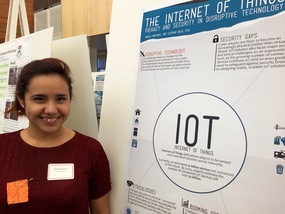Title: The Internet of Things: Examining Privacy and Security in a Booming Industry
Supervisor: Amy Csizmar Dalal, associate professor of computer science
Nayely Martinez ’16, a computer science major from Los Angeles, spent the summer working at a Minneapolis tech start-up focused on security gaps within a burgeoning industry known as the Internet of Things (IoT)—physical objects that are embedded with sensors and network connectivity to collect and exchange data remotely. As Martinez’s research summary states: “Computers and phones are no longer the only devices transferring information. ‘Smart’ cars, TVs, houses, even whole cities, are beginning to turn to IoT as a way to automatize previously manual tasks. However, this flourishing industry also faces major security and ethical challenges on an unprecedented level.”
What’s your research on?
The Internet of Things is basically being called the Twitter of machines. It connects devices up to the Internet, to the cloud, so they can communicate. You can think of a domestic appliance—say a refrigerator—that could detect that you’ve run out of milk. It would relay that information to your local grocery store, which could then have it delivered to you.
In terms of infrastructure, this means the idea of smart cities in the future. Smart roads. Self-driving cars. It could also be something like waste management, where in urban areas with trash cans that are full, there would be hardware embedded in them that could relay information to a local waste management facility.
What did you discover?
Well, this is a booming tech industry, spread out within a lot of different sectors. There are a lot of security gaps. Usually you think of hacking as something that is remote interference—someone at a computer trying to interfere. But here, it would become more of a physical issue. There’s hardware embedded in these kinds of things, so people could physically come up and tweak them to interfere later on.
There’s also the issue of ethics. In the future, you could have cities with smart grids, smart roads, but if lower income neighborhoods in urban areas are not able to fund these, it’ll create an issue of haves and have-nots.
How close are we to the reality of this?
Right now, there are 10 billion devices connected to each other. By 2020, that could increase to 50 billion. The kinds of devices vary. It could be as huge as a city or as small as a domestic appliance. Tech start-ups are very keen on getting in on this booming industry. But the problem they’re running into is that the security work that goes into each device is so customized, it’s hard to streamline and make everything cohesive.
You hear about these things on the front end—smart house, smart fridge—and it all sounds great. It’s seen as an extension of the smart phone. But from the backstage area—once you start to do the research and look at the actual hardware, technical components that go into it—it doesn’t feel quite as magical. It also reveals huge problems that can come up if companies aren’t careful in the way they go about designing solutions.
What’s your biggest takeaway from the research?
The research is ongoing, but personally, I didn’t realize how big the security gaps were. I heard on a surface level about them and figured that hacking would be possible, but by peeling back the layers and going into each of the specifications, you can see the wide extent and reach IoT can have on any sector. Whether it’s infrastructure, industrial, domestic—it’s impressive, but also daunting.
Are you ready to embrace this level of technology?
Ultimately, I think I would embrace it and grow used to it. But it’s really pushing control away. And humans crave control. Even if we’re not in control, we like to pretend we are. When driving a car, at least we’re handling the steering wheel. Again, it’s daunting, but also exciting when done the right way. The issues are being addressed, but it’s in the very beginning stages.

